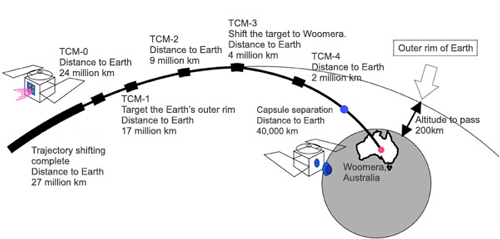T
telfrow
Guest
Japan’s Hayabusa spacecraft has spotted its quarry - a 630-metre-long asteroid named Itokawa. In September 2005, Hayabusa will try to rendezvous with the asteroid and, eventually, touch its surface.
If it succeeds, Hayabusa will be the first ever mission to bring back samples from an asteroid. Scientists could then compare the raw asteroid material to meteorites on Earth to find a good match. Once Itokawa’s composition and spectra is known, it could help determine the chemical make-up of other asteroids just by comparing their spectral characteristics, recorded by Earth-based observatories.
Unlike NASA’s high-profile Deep Impact probe, which crashed into Comet Tempel-1 on 4 July 2005, Hayabusa has not attracted a lot of public attention. “This is a stealth mission,” says NASA’s Don Yeomans, the US project scientist for the mission. “Nobody knows it’s there.”
Hayabusa’s cameras first sighted Itokawa on 29 July. Currently, the spacecraft is less than 35,000 kilometres from the asteroid. The pictures it has been gathering will help guide the spacecraft to its quarry.
Full story here: http://www.newscientistspace.com/articl ... rget-.html
Made weak by time and fate, but strong in will to strive, to seek, to find and not to yeild. - Tennyson
If it succeeds, Hayabusa will be the first ever mission to bring back samples from an asteroid. Scientists could then compare the raw asteroid material to meteorites on Earth to find a good match. Once Itokawa’s composition and spectra is known, it could help determine the chemical make-up of other asteroids just by comparing their spectral characteristics, recorded by Earth-based observatories.
Unlike NASA’s high-profile Deep Impact probe, which crashed into Comet Tempel-1 on 4 July 2005, Hayabusa has not attracted a lot of public attention. “This is a stealth mission,” says NASA’s Don Yeomans, the US project scientist for the mission. “Nobody knows it’s there.”
Hayabusa’s cameras first sighted Itokawa on 29 July. Currently, the spacecraft is less than 35,000 kilometres from the asteroid. The pictures it has been gathering will help guide the spacecraft to its quarry.
Full story here: http://www.newscientistspace.com/articl ... rget-.html
Made weak by time and fate, but strong in will to strive, to seek, to find and not to yeild. - Tennyson





